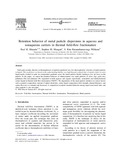| dc.contributor.author | Shiundu, Paul M. | |
| dc.contributor.author | Williams, S. Kim Ratanathanawongs | |
| dc.contributor.author | Mungutia, Stephen M | |
| dc.date.accessioned | 2013-05-30T11:44:23Z | |
| dc.date.available | 2013-05-30T11:44:23Z | |
| dc.date.issued | 2003-01 | |
| dc.identifier.citation | J Chromatogr A. 2003 Jan 3;983(1-2):163-76. | en |
| dc.identifier.uri | http://profiles.uonbi.ac.ke/pmshiundu/publications/retention-behavior-metal-particle-dispersions-aqueous-and-nonaqueous-carriers | |
| dc.identifier.uri | http://erepository.uonbi.ac.ke:8080/xmlui/handle/123456789/27631 | |
| dc.identifier.uri | http://www.ncbi.nlm.nih.gov/pubmed/12568380 | |
| dc.description.abstract | Until quite recently, theories on thermophoresis of particles predicted very low thermophoretic velocities of metal particles
in liquids. This prediction was based on the understanding that the very high thermal conductivities of metals relative to most
liquid media resulted in quite low temperature gradients across the metal particle thereby leading to low net force on the
particle. In this paper, we report the retention behavior of submicrometer size metal particles of silver (Ag), gold (Au),
palladium (Pd) and platinum (Pt) suspended in both aqueous and organic (specifically, acetonitrile and tetrahydrofuran)
carrier liquids in thermal field-flow fractionation (ThFFF). The dependence of the metal particle retention on various factors
such as particle composition, amount of added electrolyte, carrier liquid composition, field strength, channel thickness, and
carrier flow-rate is evaluated and discussed. A comparison in particle retention behavior among equal-sized metal, latex and
silica particles is also provided. | |
| dc.language.iso | en | en |
| dc.title | Retention Behavior of Metal Particle Dispersions in Aqueous and Nonaqueous Carriers in Thermal Field-Flow Fractionation | en |
| dc.type | Article | en |
| local.publisher | Department of Chemistry | en |

